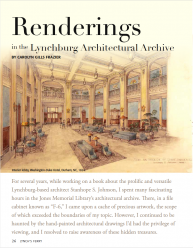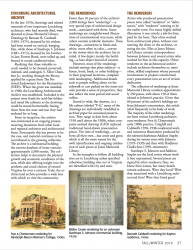Renderings in the Lynchburg Architectural Archive


For several years, while working on a book about the prolific and versatile Lynchburg-based architect Stanhope S. Johnson, I spent many fascinating hours in the Jones Memorial Library’s architectural archive. There, in a file cabinet known as “F-6,” I came upon a cache of precious artwork, the scope of which exceeded the boundaries of my topic. However, I continued to be
haunted by the hand-painted architectural drawings I’d had the privilege of viewing, and I resolved to raise awareness of these hidden treasures.
haunted by the hand-painted architectural drawings I’d had the privilege of viewing, and I resolved to raise awareness of these hidden treasures.
In the late 1970s, drawings and related materials of two important Lynchburg architects, who had recently died, were donated to Jones Memorial Library. Drawings by Bennett B. Cardwell (1893–1975), donated by his widow, had been stored on vertical, hanging files, while those of Stanhope S. Johnson (1881–1973), donated by his brother-in-law, Everett Bond, were rolled up and bound in round cardboard tubes.
Realizing that these valuable records needed to be cleaned, preserved, indexed, and cataloged, S. Allen Chambers Jr., working through the library, applied for a grant from The National Endowment for the Humanities (NEH). When the grant was awarded, in 1980, the Lynchburg Architectural Archive was established. Included in the project were funds for acid-free folders and metal file cabinets so the drawings could be stored horizontally, freeing them from the wear and tear they had endured for so long.
Realizing that these valuable records needed to be cleaned, preserved, indexed, and cataloged, S. Allen Chambers Jr., working through the library, applied for a grant from The National Endowment for the Humanities (NEH). When the grant was awarded, in 1980, the Lynchburg Architectural Archive was established. Included in the project were funds for acid-free folders and metal file cabinets so the drawings could be stored horizontally, freeing them from the wear and tear they had endured for so long.
From its inception, the archive was envisioned as an ongoing project, receiving donations from other local and regional architects and architectural firms. Fortunately this has proven to be the case, and material continues to be contributed to the growing collection. The archive is a substantial holding; the current database of items contains approximately 3,900 entries. The collection helps to document the physical growth and economic conditions of the area, while also offering insight into the aesthetic and social choices of central Virginia for over a century. Truly, the architectural archive provides a wide lens with which to view the community.
^ Top
Previous page: Horse Ford to Glass Memorial: The Lynches Establish and Hold a Crossing on the Fluvanna River
Next page: Spring 2020
Site Map




